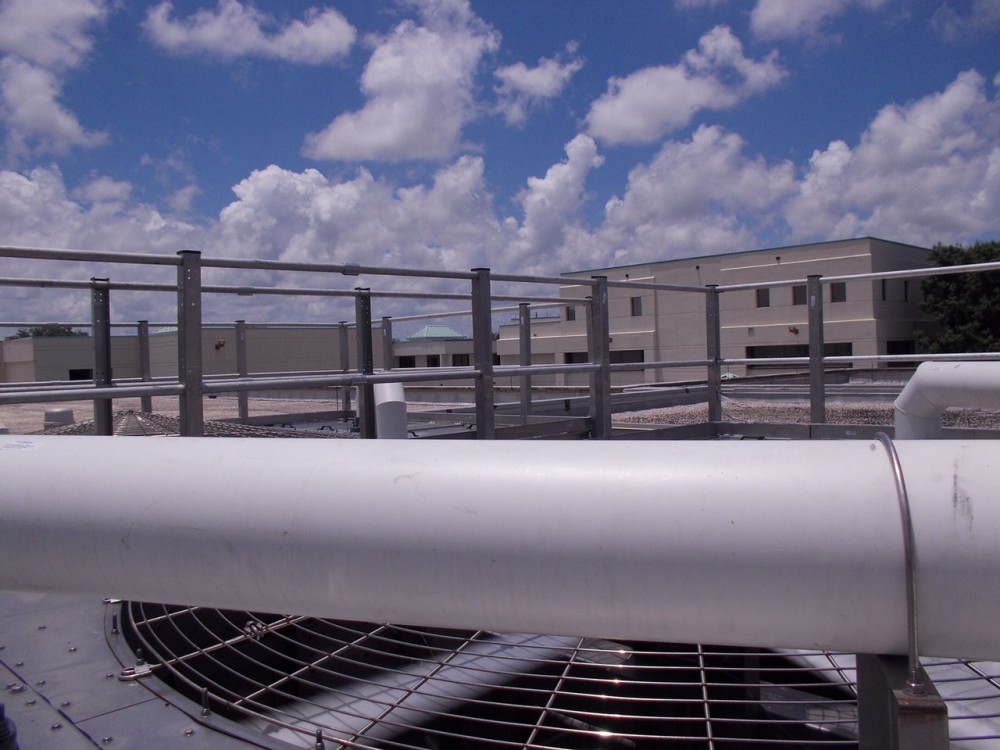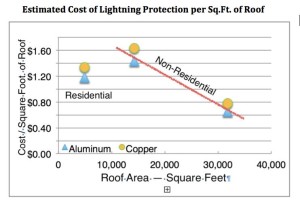Risk assessment and costs for lightning protection
by Erik Missio | July 31, 2015 9:07 am
 [1]
[1]By Jennifer A. Morgan, CSI, and Michael Chusid, RA, FCSI, CCS
In the August 2015 issue[2] of The Construction Specifier, these authors explored numerous aspects of lightning protection, from functionality to aesthetics. In this complementary web article, the focus turns to risk assessment and associated costs.
Neither the National Electrical Code (NEC)[3] nor most local building codes require lightning protection. Instead, the decision to install lightning protection is at the discretion of a building owner and the owner’s risk management advisers, insurance underwriters, and design professionals.
In National Fire Protection Association (NFPA) 780[4], Standard for the Installation of Lightning Protection Systems, Annex L covers lightning risk assessment and takes into account the building’s environment, construction type, occupancy, contents, the consequences of a lightning strike, and other factors. It cautions:
There are some cases where the need for protection should be given serious consideration regardless of the outcome of the risk assessment.
Particular consideration should be given to tall, isolated structures, as well as buildings with:
- large crowds;
- critical services;
- high lightning flash frequency;
- explosive or flammable materials;
- irreplaceable cultural heritage; and
- statutory, regulatory, or insurance requirements that take precedence over risk assessment.
Lightning strikes on construction sites should also be considered. Issues include:
- lightning protection for temporary facilities such as cranes, site offices, and scaffolding;
- extending lightning protection as the superstructure rises and critical equipment is placed; and
- training and management protocols to protect workers in the field against lightning.
This is of particular concern on large construction sites since they have greater exposure than compact sites and shelter for workers may be located at a distance. The best advice is, “When thunder roars, go indoors.”[5]
Costs
These authors recently surveyed 21 lightning protection installers across the United States to obtain cost estimates of installing lightning protection on three hypothetical buildings: A single-family residence, a low-rise high school, and a five-story office building. The findings[6] provide cost-estimating guidelines for use during the planning and design phases of construction projects.
In nonresidential buildings, the roof area is the most significant factor in determining the work required to install lightning protection. Hence, multistory buildings will generally cost less per square foot of interior floor area. In the hypothetical building, for example, the cost based on the roof area can be divided by five to estimate the cost based on floor area.
 [7]Costs will generally be more in buildings with extensive roof top equipment and demanding architectural considerations; less in building with a modicum of rooftop equipment and a simple configuration. Buildings taller than 23 m (75 ft)—Class II—incur additional expenses. These estimates do not apply to buildings that house explosives and other special occupancies.
[7]Costs will generally be more in buildings with extensive roof top equipment and demanding architectural considerations; less in building with a modicum of rooftop equipment and a simple configuration. Buildings taller than 23 m (75 ft)—Class II—incur additional expenses. These estimates do not apply to buildings that house explosives and other special occupancies.
In typical single-family homes with pitched roofs, air terminals need only be installed at the roof ridge, not the perimeter of the roof. This explains why lightning protection costs for the home in the study is below the trend line shown for non-residential construction.
It is important to remember, features such as dormers, chimneys, balconies, skylights, and rooftop equipment can add to the cost.
An example of a non-proprietary guide specification for a lightning protection assembly, written by these authors, can be downloaded from here[8].
Jennifer A. Morgan CSI, is an officer of East Coast Lightning Equipment Inc., an UL-Listed manufacturer of lightning protection components. She also teaches continuing education programs for Lightning Safety Alliance. Morgan can be reached at www.ecle.biz[9].
Michael Chusid, RA, FCSI, CCS, is a frequent contributor to The Construction Specifier and a product innovation and marketing consultant to building product manufacturers.
He can be reached at www.buildingproduct.guru[10].
- [Image]: http://www.constructionspecifier.com/wp-content/uploads/2015/07/DSCN1002.jpg
- August 2015 issue: http://www.constructionspecifier.com/lightning-protection-and-the-building-envelope/
- National Electrical Code (NEC): http://www.nfpa.org/codes-and-standards/document-information-pages?mode=code&code=70
- National Fire Protection Association (NFPA) 780: http://www.nfpa.org/codes-and-standards/document-information-pages?mode=code&code=780
- “When thunder roars, go indoors.”: http://www.lightningsafety.noaa.gov/safety.shtml
- findings: http://www.ecle.biz/coststudy
- [Image]: http://www.constructionspecifier.com/wp-content/uploads/2015/07/Graphic.jpg
- here: http://www.constructionspecifier.com/lightning-specs
- www.ecle.biz: http://www.ecle.biz
- www.buildingproduct.guru: http://www.buildingproduct.guru
Source URL: https://www.constructionspecifier.com/lightning-risk/